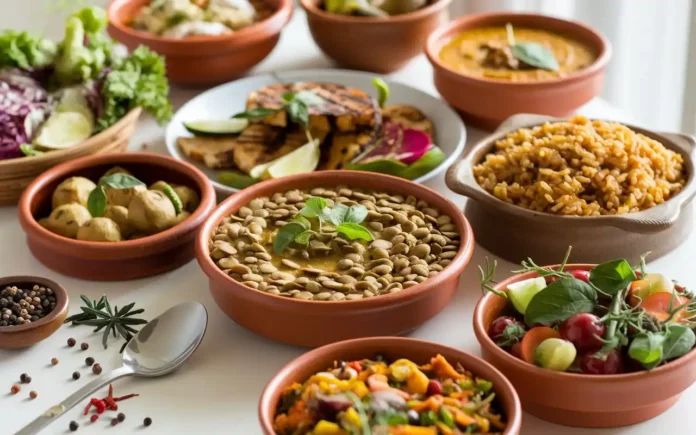Indian Diet for Weight Loss: Comprehensive Guide
Disclaimer: This article is intended for informational purposes only and does not constitute medical advice. Always consult with a healthcare professional before starting any new diet or weight loss plan.
1. Introduction to Indian Diet for Weight Loss
The Indian diet for weight loss is essential because it combines traditional flavors with nutritional balance, making it easier to shed pounds without sacrificing taste. Rooted in diverse culinary practices, this diet emphasizes whole foods, spices, and balanced meals that support metabolism and overall health.
In this guide, we’ll explore how incorporating Indian dietary principles can help you achieve your weight loss goals effectively and sustainably.
India’s rich culinary heritage offers a plethora of dishes that are not only delicious but also packed with nutrients essential for weight management. By focusing on plant-based ingredients, lean proteins, and metabolism-boosting spices, the Indian diet provides a holistic approach to weight loss.
Moreover, the flexibility of the Indian diet allows it to be adapted to various dietary preferences and restrictions, making it accessible to a wide range of individuals seeking to lose weight.
2. Benefits of an Indian Diet for Weight Loss
The Indian diet for weight loss offers numerous benefits that go beyond mere calorie restriction. Here are some key advantages:
- Rich in Nutrients: Incorporates a variety of vegetables, legumes, and spices that provide essential vitamins and minerals.
- High in Fiber: Whole grains and legumes promote satiety, reducing overall calorie intake.
- Metabolism Boosting: Spices like turmeric and ginger enhance metabolic rate and aid digestion.
- Balanced Macronutrients: Ensures a healthy balance of carbohydrates, proteins, and fats.
- Flexibility: Can be tailored to various dietary preferences, including vegan, vegetarian, and gluten-free options.
- Promotes Gut Health: Fermented foods like yogurt and buttermilk support a healthy gut microbiome.
- Low in Processed Foods: Emphasizes whole, unprocessed ingredients, reducing intake of unhealthy fats and sugars.
Additionally, the use of spices not only adds flavor but also provides numerous health benefits, including anti-inflammatory and antioxidant properties. This combination makes the Indian diet a powerful tool for weight loss and overall well-being.
3. Key Components of an Indian Diet for Weight Loss
The Indian diet for weight loss is built on several foundational components that ensure nutritional adequacy while promoting fat loss. These include:
3.1 Whole Grains
Whole grains like brown rice, quinoa, and millet provide sustained energy and are rich in fiber, aiding in digestion and weight management. Unlike refined grains, whole grains retain their natural nutrients and help maintain stable blood sugar levels.
- Brown Rice: A staple in many Indian dishes, brown rice is high in fiber and helps keep you full longer.
- Quinoa: A complete protein source that is gluten-free and versatile in various recipes.
- Millet: An ancient grain that is rich in magnesium and antioxidants.
3.2 Legumes and Lentils
Legumes such as lentils, chickpeas, and beans are excellent sources of plant-based protein, helping to keep you full longer and support muscle maintenance during weight loss.
- Dal: A lentil-based dish that is both nutritious and filling.
- Chickpea Curry: High in protein and fiber, perfect for a hearty meal.
- Black Beans: Can be used in salads and stews for added protein.
3.3 Fresh Vegetables
Incorporating a variety of vegetables ensures a high intake of vitamins, minerals, and antioxidants. Vegetables are low in calories but high in volume, making them ideal for weight loss.
- Leafy Greens: Spinach, kale, and fenugreek leaves are nutrient-dense and versatile.
- Cruciferous Vegetables: Broccoli, cauliflower, and cabbage support detoxification and metabolism.
- Root Vegetables: Carrots, beets, and sweet potatoes provide complex carbohydrates and fiber.
3.4 Healthy Fats
Healthy fats from sources like ghee, olive oil, and nuts support metabolism and hormone balance. These fats are essential for the absorption of fat-soluble vitamins and provide long-lasting energy.
- Ghee: Clarified butter used in moderation for cooking and flavor.
- Olive Oil: Ideal for salad dressings and low-heat cooking.
- Nuts and Seeds: Almonds, walnuts, chia seeds, and flaxseeds are excellent sources of healthy fats.
3.5 Spices and Herbs
Spices such as turmeric, cumin, and coriander not only add flavor but also possess anti-inflammatory and metabolism-boosting properties. Herbs like cilantro and mint enhance digestion and detoxification.
- Turmeric: Contains curcumin, known for its anti-inflammatory benefits.
- Cumin: Aids in digestion and improves nutrient absorption.
- Coriander: Helps in reducing blood sugar levels and supports heart health.
4. Sample Meal Plans
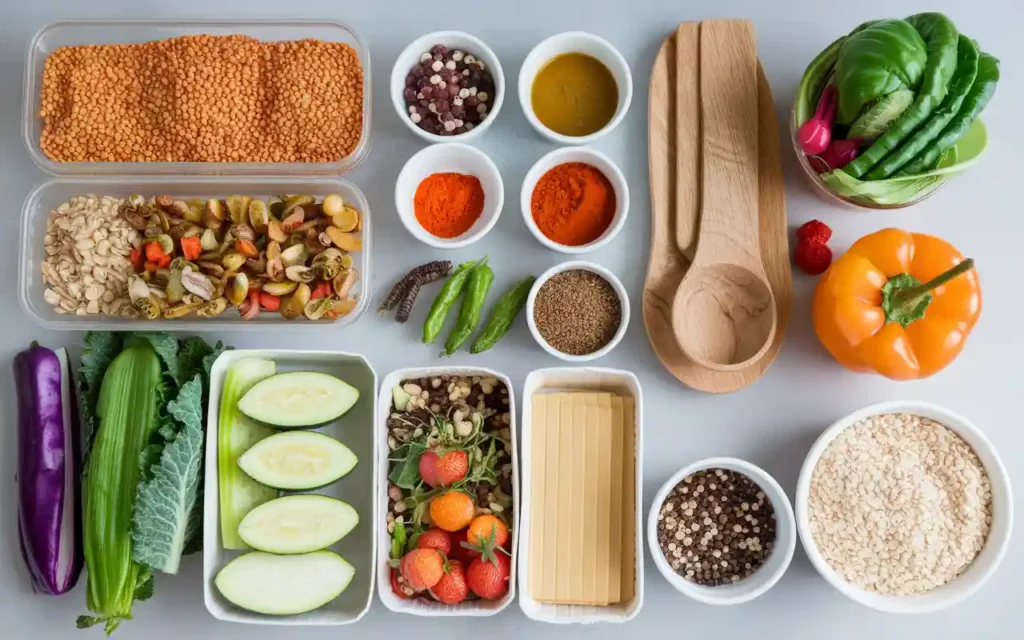
The Indian diet for weight loss includes a variety of meals that are both satisfying and nutritious. Here’s a sample meal plan to get you started:
4.1 Breakfast
- Vegetable Upma: Made with semolina and mixed vegetables, providing a hearty start to the day.
- Masala Chia Pudding: Chia seeds soaked with almond milk and flavored with cardamom and nuts, offering a protein-rich and fiber-packed option.
- Oats Poha: A twist on traditional poha using oats instead of flattened rice, increasing the fiber content.
4.2 Mid-Morning Snack
- Fresh Fruit Salad: A mix of seasonal fruits like papaya, apple, and berries, providing natural sweetness and essential vitamins.
- Buttermilk: Spiced with roasted cumin powder and a pinch of salt, aiding in digestion and hydration.
- Roasted Makhana: Lightly spiced fox nuts for a crunchy, low-calorie snack.
4.3 Lunch
- Quinoa Pulao: Quinoa cooked with vegetables and spices, offering a high-protein alternative to traditional rice pulao.
- Dal Tadka: Lentil soup tempered with garlic and spices, providing a rich source of protein and fiber.
- Mixed Vegetable Sabzi: A variety of sautéed vegetables for a nutrient-dense side dish.
- Whole Wheat Roti: Traditional Indian bread made with whole wheat flour, offering complex carbohydrates.
- Salad: Fresh cucumber, tomato, and carrot salad with lemon dressing.
4.4 Afternoon Snack
- Roasted Chickpeas: Lightly spiced and roasted for a crunchy snack high in protein and fiber.
- Green Tea: Infused with mint leaves, boosting metabolism and providing antioxidants.
- Sprout Salad: Mixed sprouts with onions, tomatoes, and a dash of lemon juice.
4.5 Dinner
- Grilled Paneer: Marinated paneer cubes grilled with spices, offering a high-protein main course.
- Cauliflower Rice: Finely grated cauliflower cooked with peas and carrots, serving as a low-carb alternative to rice.
- Spinach Soup: A light and nutritious spinach-based soup, rich in iron and vitamins.
- Mixed Dal: A combination of different lentils cooked with spices for a hearty meal.
- Herbal Tea: Calming tea with herbs like chamomile or tulsi to aid digestion.
4.6 Post-Dinner
- Warm Turmeric Milk: Almond milk heated with a dash of turmeric, promoting relaxation and anti-inflammatory benefits.
- Digestive Spice Mix: A small spoon of fennel seeds or ajwain to aid digestion.
4.7 Weekly Variations
To prevent monotony and ensure a balanced intake of nutrients, it’s beneficial to vary your meal plans weekly. Incorporate different vegetables, proteins, and grains to keep your diet interesting and nutritionally comprehensive.
- Monday: Start the week with a focus on high-fiber meals to kickstart metabolism.
- Wednesday: Introduce more plant-based proteins like tofu and tempeh.
- Friday: Incorporate lean meats or seafood for additional protein diversity.
- Weekend: Allow for slightly more indulgent meals while maintaining portion control.
5. Top Indian Superfoods for Weight Loss
The Indian diet for weight loss leverages several superfoods known for their weight management properties. Here are the top superfoods to include in your diet:
- Turmeric: Contains curcumin, which has anti-inflammatory and metabolism-boosting effects.
- Ginger: Aids digestion and reduces appetite.
- Chia Seeds: High in fiber and omega-3 fatty acids.
- Green Tea: Enhances fat oxidation and improves metabolic rate.
- Almonds: Provide healthy fats and promote satiety.
- Fenugreek: Helps regulate blood sugar levels and reduces hunger.
- Spinach: Low in calories and rich in nutrients.
- Quinoa: A complete protein source that keeps you full longer.
- Flaxseeds: High in fiber and promote digestive health.
- Black Pepper: Enhances nutrient absorption and boosts metabolism.
Incorporating these superfoods into your daily meals can significantly enhance the effectiveness of your weight loss efforts. Here’s how you can include them:
- Add Turmeric and Black Pepper: Spice up your curries and soups with turmeric and a pinch of black pepper to maximize curcumin absorption.
- Start Your Day with Chia Seeds: Mix chia seeds into your morning pudding or smoothies for an added fiber boost.
- Snack on Almonds: Replace unhealthy snacks with a handful of almonds to curb hunger and provide healthy fats.
- Enjoy Green Tea: Replace sugary beverages with green tea to aid metabolism.
- Include Spinach in Meals: Add spinach to your smoothies, soups, and salads for a nutrient-dense boost.
6. Delicious Indian Recipes for Weight Loss
The Indian diet for weight loss doesn’t mean compromising on taste. Here are some delicious recipes that are both healthy and satisfying:
6.1 Tandoori Chicken
Marinated chicken pieces grilled to perfection with spices and yogurt. This high-protein dish is low in fat and perfect for a satisfying meal.
Ingredients:
- 500g chicken breast, cut into pieces
- 1 cup yogurt
- 2 tbsp tandoori masala
- 1 tbsp lemon juice
- 2 cloves garlic, minced
- 1-inch ginger, grated
- Salt to taste
- Fresh coriander for garnish
Instructions:
- In a large bowl, mix yogurt, tandoori masala, lemon juice, garlic, ginger, and salt.
- Add the chicken pieces to the marinade and coat well. Let it marinate for at least 2 hours, preferably overnight.
- Preheat the grill or oven to 200°C (392°F).
- Place the marinated chicken pieces on the grill and cook for 20-25 minutes, turning occasionally, until fully cooked.
- Garnish with fresh coriander and serve with a side of salad or grilled vegetables.
6.2 Palak Paneer
Creamy spinach curry with paneer cubes, rich in protein and iron. This vegetarian dish is both nutritious and delicious.
Ingredients:
- 200g paneer, cubed
- 500g fresh spinach, blanched and pureed
- 1 onion, finely chopped
- 2 tomatoes, pureed
- 2 cloves garlic, minced
- 1-inch ginger, grated
- 2 green chilies, slit
- 1 tsp cumin seeds
- 1 tsp garam masala
- 1 tsp turmeric powder
- 1 tsp coriander powder
- 2 tbsp olive oil
- Salt to taste
- Fresh cream (optional)
Instructions:
- Heat olive oil in a pan and add cumin seeds. Let them splutter.
- Add onions, garlic, ginger, and green chilies. Sauté until onions are golden brown.
- Stir in the tomato puree and cook until the oil separates from the mixture.
- Add turmeric, coriander powder, and salt. Mix well.
- Pour in the spinach puree and simmer for 10 minutes.
- Add paneer cubes and garam masala. Cook for another 5 minutes.
- Optionally, add a splash of fresh cream for extra richness.
- Garnish with fresh cream and serve hot with whole wheat roti or brown rice.
6.3 Moong Dal Chilla
Savory pancakes made from moong dal batter, perfect for breakfast or snacks. High in protein and easy to prepare.
Ingredients:
- 1 cup moong dal (split green gram), soaked overnight
- 1 onion, finely chopped
- 1 tomato, finely chopped
- 2 green chilies, finely chopped
- 1-inch ginger, grated
- 1 tsp cumin seeds
- Fresh coriander leaves, chopped
- Salt to taste
- Oil for cooking
Instructions:
- Drain the soaked moong dal and blend it into a smooth batter with a little water.
- Transfer the batter to a bowl and add chopped onions, tomatoes, green chilies, ginger, cumin seeds, coriander leaves, and salt. Mix well.
- Heat a non-stick pan and lightly grease it with oil.
- Pour a ladleful of batter onto the pan and spread it into a thin pancake.
- Cook on medium heat until the edges lift, then flip and cook the other side until golden brown.
- Repeat with the remaining batter.
- Serve hot with chutney or yogurt.
6.4 Vegetable Biryani
Fragrant rice dish cooked with mixed vegetables and aromatic spices. A balanced meal rich in carbohydrates, proteins, and vitamins.
Ingredients:
- 1 cup brown rice, washed and soaked for 30 minutes
- 2 cups mixed vegetables (carrots, peas, beans, cauliflower)
- 1 onion, sliced
- 2 tomatoes, pureed
- 2 cloves garlic, minced
- 1-inch ginger, grated
- 2 green chilies, slit
- 1 tsp cumin seeds
- 1 tsp garam masala
- 1 tsp turmeric powder
- 1 tsp coriander powder
- 2 tbsp olive oil
- Salt to taste
- Fresh coriander and mint leaves for garnish
- 2 cups water
Instructions:
- Heat olive oil in a large pot and add cumin seeds. Let them splutter.
- Add onions, garlic, ginger, and green chilies. Sauté until onions are translucent.
- Stir in the tomato puree and cook until the oil separates.
- Add turmeric, coriander powder, and salt. Mix well.
- Add mixed vegetables and cook for 5-7 minutes until they are slightly tender.
- Add soaked brown rice and mix gently with the vegetables and spices.
- Pour in 2 cups of water, cover the pot, and let it simmer until the rice is cooked and water is absorbed.
- Sprinkle garam masala and garnish with fresh coriander and mint leaves before serving.
6.5 Raita
Refreshing yogurt-based side dish with cucumbers and spices. Helps in digestion and adds a cooling element to your meals.
Ingredients:
- 1 cup plain yogurt
- 1 cucumber, grated
- 1 tomato, finely chopped
- 1 green chili, finely chopped (optional)
- 1 tsp roasted cumin powder
- Fresh coriander leaves, chopped
- Salt to taste
Instructions:
- Whisk the yogurt until smooth and creamy.
- Add grated cucumber, chopped tomato, and green chili to the yogurt.
- Mix in roasted cumin powder and salt.
- Garnish with fresh coriander leaves.
- Serve chilled as a side dish with your main meals.
7. Intermittent Fasting and Indian Diet for Weight Loss
The Indian diet for weight loss can be effectively combined with intermittent fasting to enhance results. Intermittent fasting involves cycling between periods of eating and fasting, which can help reduce calorie intake and improve metabolism.
Here’s how to integrate intermittent fasting with your Indian diet:
- 16/8 Method: Fast for 16 hours and eat during an 8-hour window, typically skipping breakfast and having lunch and dinner within the window.
- 5:2 Diet: Eat normally for five days and restrict calories to 500-600 on two non-consecutive days.
- Eat-Stop-Eat: Once or twice a week, do a 24-hour fast.
During eating periods, focus on nutrient-dense Indian meals that support satiety and energy levels. Here are some tips:
- Hydrate: Drink plenty of water, herbal teas, and infused water during fasting periods to stay hydrated.
- Balanced Meals: Ensure your meals include a good balance of proteins, healthy fats, and complex carbohydrates.
- Avoid Processed Foods: Stick to whole, unprocessed foods to maximize nutrient intake and support weight loss.
- Listen to Your Body: Pay attention to hunger and fullness cues to avoid overeating during eating windows.
Intermittent fasting, when combined with an Indian diet for weight loss, can lead to improved metabolic health, increased fat burning, and enhanced overall well-being.
8. Low-Carb Indian Diet Plans
The Indian diet for weight loss can be adapted to low-carb preferences, making it suitable for those aiming to reduce carbohydrate intake. A low-carb Indian diet focuses on high-protein and high-fat foods while minimizing rice, bread, and sugary items.
Here are some strategies to create a low-carb Indian meal plan:
- Replace Rice: Use cauliflow
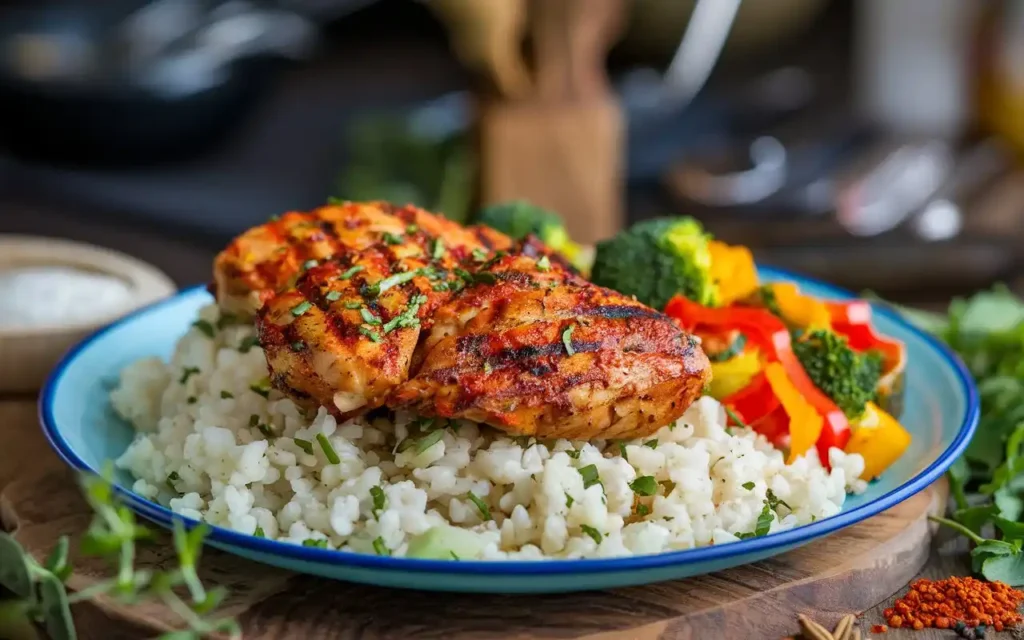 er rice or shirataki rice as substitutes. These alternatives are low in carbohydrates and can be flavored with Indian spices for added taste.
er rice or shirataki rice as substitutes. These alternatives are low in carbohydrates and can be flavored with Indian spices for added taste. - Choose Low-Carb Vegetables: Opt for leafy greens, broccoli, bell peppers, and zucchini which are low in carbs and high in fiber.
- Incorporate Healthy Fats: Use ghee, coconut oil, and olive oil in moderation to support satiety and energy.
- Protein-Rich Foods: Include paneer, chicken, fish, and legumes in your meals to maintain muscle mass and promote fullness.
- Limit Bread Intake: Choose low-carb alternatives like almond flour rotis or skip bread and focus on protein-rich main dishes.
8.1 Sample Low-Carb Meal Plan
Breakfast:
- Egg Bhurji: Scrambled eggs with tomatoes, onions, and spices.
- Avocado Smoothie: Blended avocado with spinach, almond milk, and a touch of turmeric.
Lunch:
- Grilled Chicken Salad: Mixed greens with grilled chicken, cucumber, and a lemon-tahini dressing.
- Palak Paneer: Spinach and paneer curry served with cauliflower rice.
Afternoon Snack:
- Nut Mix: A handful of almonds, walnuts, and pumpkin seeds.
- Cheese Slices: Low-fat cheese slices with a sprinkle of black pepper.
Dinner:
- Fish Curry: Fish cooked in a spiced tomato and coconut gravy.
- Stir-Fried Vegetables: A mix of bell peppers, broccoli, and zucchini sautéed with Indian spices.
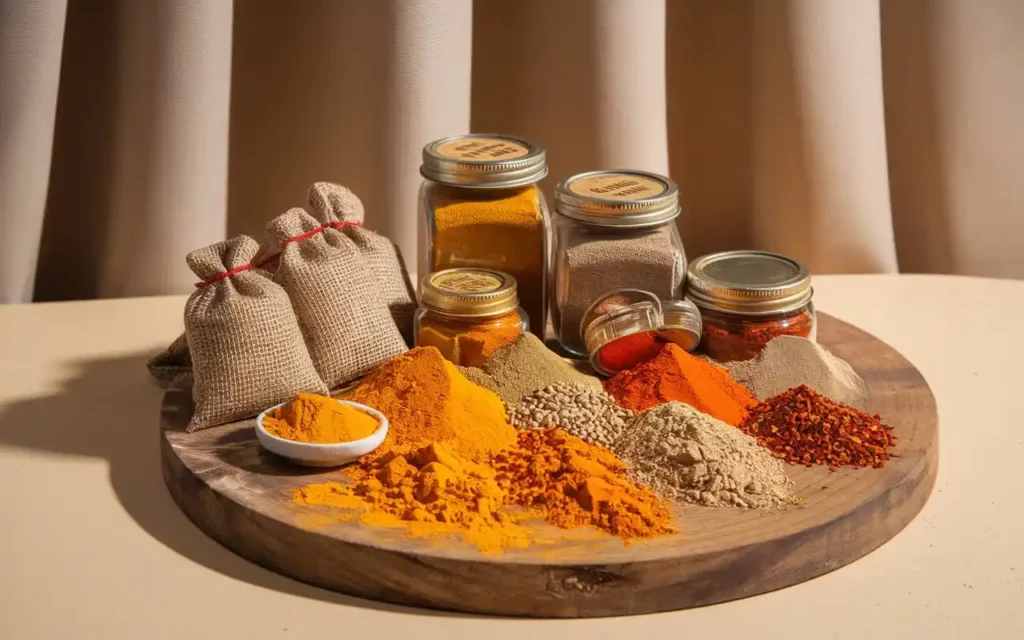
By following a low-carb Indian diet for weight loss, you can effectively reduce your carbohydrate intake while still enjoying flavorful and satisfying meals.
9. Plant-Based Indian Diet Strategies
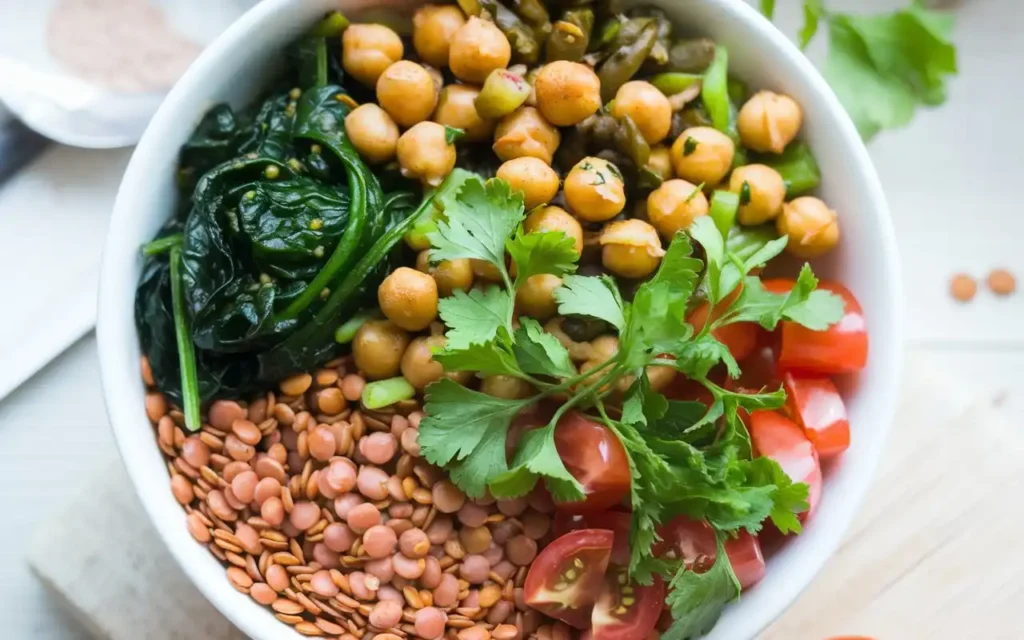
The Indian diet for weight loss can be effectively tailored to a plant-based regimen, promoting not only weight loss but also overall health and sustainability. Plant-based diets emphasize vegetables, fruits, legumes, and whole grains while minimizing or eliminating animal products.
Here are key strategies for a plant-based Indian diet:
- Protein Sources: Incorporate lentils, chickpeas, tofu, and tempeh to ensure adequate protein intake.
- Whole Grains: Use quinoa, millet, and brown rice for sustained energy and fiber.
- Healthy Fats: Include nuts, seeds, and avocados to support metabolism and satiety.
- Spices and Herbs: Enhance flavor with turmeric, cumin, coriander, and fresh herbs to make plant-based dishes more appealing.
- Minimize Processed Foods: Focus on whole, unprocessed ingredients to maximize nutrient density and support weight loss.
9.1 Benefits of a Plant-Based Indian Diet
- Weight Management: High in fiber and low in unhealthy fats, helping to control appetite and reduce calorie intake.
- Improved Digestion: Rich in probiotics from fermented foods like yogurt and buttermilk, promoting a healthy gut.
- Reduced Risk of Chronic Diseases: Associated with lower rates of heart disease, diabetes, and certain cancers.
- Environmental Sustainability: Plant-based diets have a lower carbon footprint and are more sustainable.
9.2 Sample Plant-Based Meal Plan
Breakfast:
- Vegetable Poha: Flattened rice cooked with peas, carrots, and spices.
- Fruit Smoothie Bowl: Blended fruits topped with nuts and seeds.
Lunch:
- Chickpea Salad: Mixed greens with chickpeas, cucumbers, tomatoes, and a lemon-tahini dressing.
- Mixed Vegetable Curry: A variety of vegetables cooked in a spiced tomato gravy.
- Whole Wheat Roti: Traditional Indian bread made with whole wheat flour.
Afternoon Snack:
- Hummus and Veggies: Homemade hummus served with carrot and cucumber sticks.
- Roasted Edamame: Lightly salted and roasted for a crunchy snack.
Dinner:
- Tofu Stir-Fry: Tofu cubes sautéed with bell peppers, broccoli, and soy sauce.
- Quinoa and Lentil Pilaf: A hearty mix of quinoa and lentils cooked with spices and vegetables.
Embracing a plant-based Indian diet for weight loss not only aids in shedding pounds but also contributes to a healthier and more sustainable lifestyle.
10. Conclusion and Final Tips
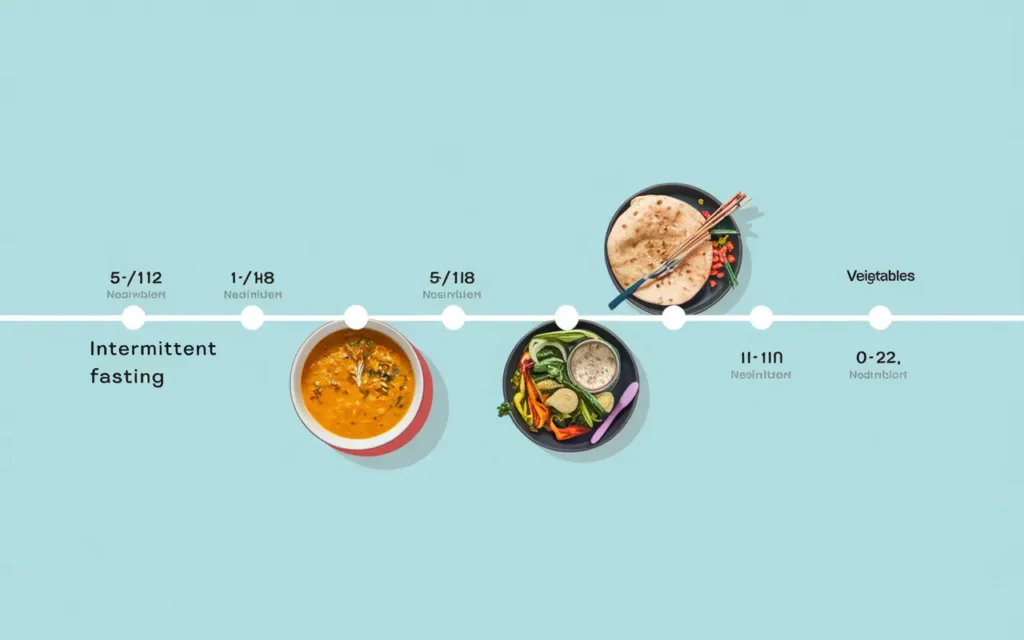
Adopting an Indian diet for weight loss can be a flavorful and effective way to achieve your health goals. By focusing on whole foods, balanced meals, and traditional spices, you can create a sustainable diet plan that supports weight loss and overall well-being.
Here are some final tips to maximize your weight loss journey:
- Stay Hydrated: Drink plenty of water throughout the day. Herbal teas and infused water can also help keep you hydrated.
- Portion Control: Be mindful of portion sizes to avoid overeating. Use smaller plates and listen to your body’s hunger signals.
- Regular Exercise: Combine your diet with regular physical activity for best results. Activities like yoga, walking, and strength training can complement your weight loss efforts.
- Consistency: Maintain consistency in your eating habits for long-term success. Avoid skipping meals and stick to your meal plans.
- Listen to Your Body: Pay attention to hunger and fullness cues. Eat when you’re hungry and stop when you’re satisfied.
- Plan Ahead: Prepare your meals in advance to avoid last-minute unhealthy choices. Meal prepping can help you stay on track.
- Limit Processed Foods: Reduce intake of processed and sugary foods that can hinder your weight loss progress.
- Get Adequate Sleep: Ensure you get enough sleep each night, as poor sleep can affect metabolism and hunger hormones.
- Manage Stress: Practice stress-reducing techniques like meditation, deep breathing, or hobbies to prevent emotional eating.
Embarking on an Indian diet for weight loss journey can be both enjoyable and rewarding. Embrace the diversity of Indian cuisine and make informed choices to support your health and weight loss goals.
11. Frequently Asked Questions
11.1 Can the Indian diet for weight loss be followed by non-vegetarians?
Absolutely! The Indian diet for weight loss is highly adaptable and can include both vegetarian and non-vegetarian options. Incorporate lean proteins like chicken, fish, and legumes to meet your dietary preferences.
11.2 Is it necessary to count calories on an Indian diet for weight loss?
While calorie counting can be helpful, it is not mandatory. Focusing on nutrient-dense foods, portion control, and balanced meals can naturally lead to a calorie deficit and weight loss.
11.3 How long does it take to see results with the Indian diet for weight loss?
Results vary depending on individual factors like metabolism, activity level, and adherence to the diet. Generally, noticeable weight loss can occur within a few weeks to a few months with consistent effort.
11.4 Can I include desserts in an Indian diet for weight loss?
Yes, but it’s important to choose healthy dessert options and enjoy them in moderation. Opt for desserts made with natural sweeteners, whole grains, and healthy fats, such as fruit-based dishes or yogurt-based sweets.
11.5 How can I maintain the Indian diet for weight loss while dining out?
Choose restaurants that offer healthy Indian options. Opt for grilled or steamed dishes, request less oil in preparation, and focus on dishes rich in vegetables and lean proteins. Avoid fried and heavily creamy dishes.
References and Further Reading

